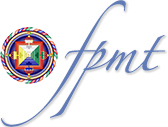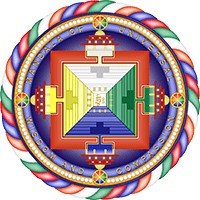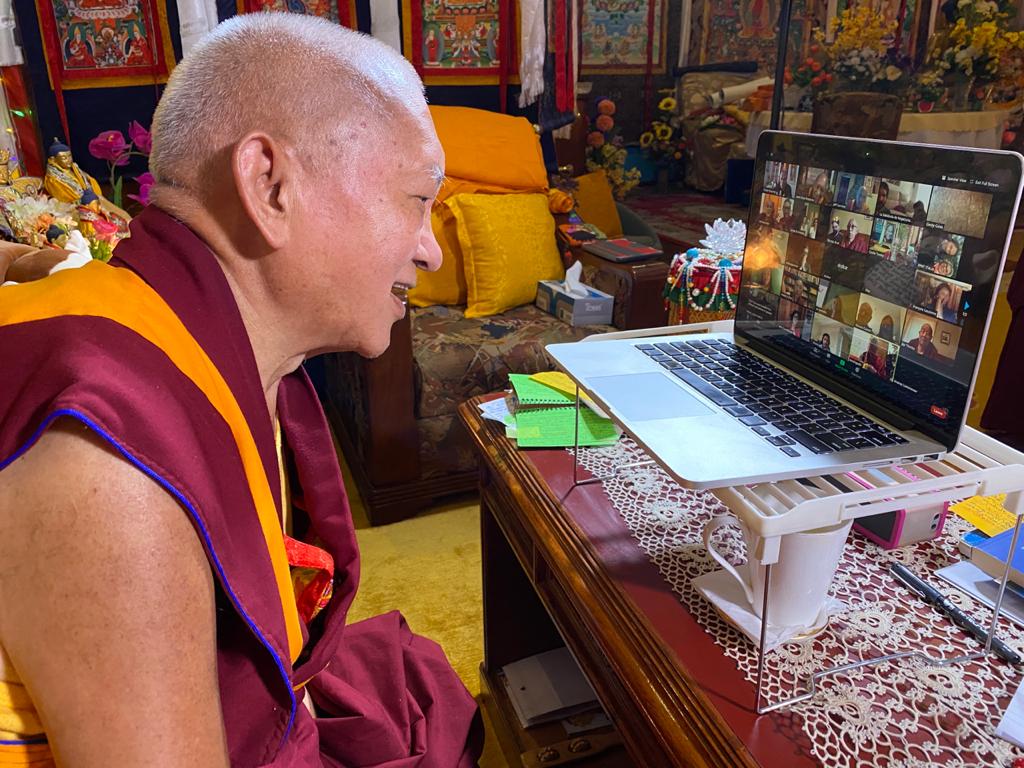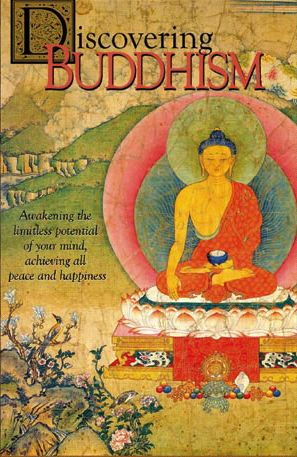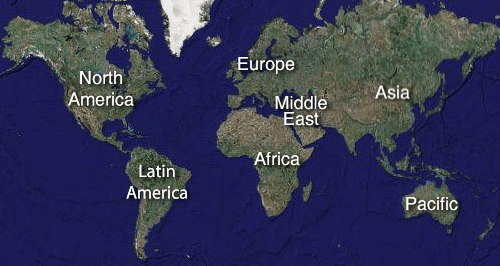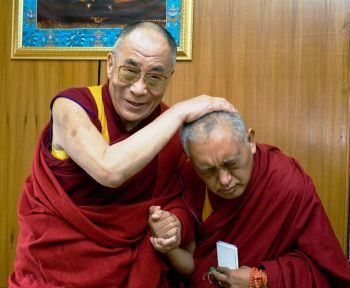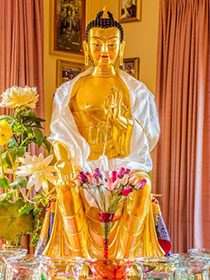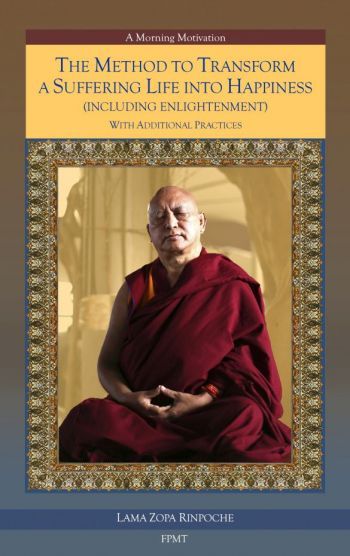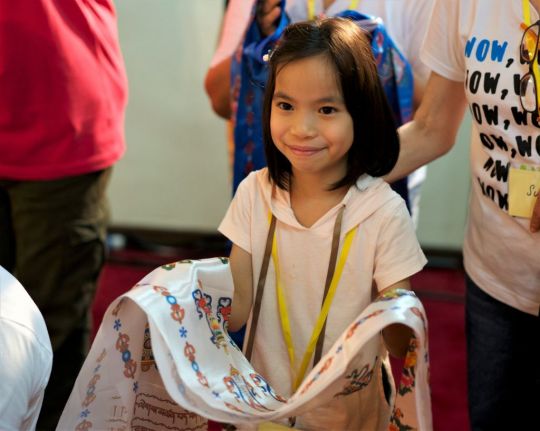- Home
- FPMT Homepage
Foundation for the Preservation of the Mahayana Tradition
The FPMT is an organization devoted to preserving and spreading Mahayana Buddhism worldwide by creating opportunities to listen, reflect, meditate, practice and actualize the unmistaken teachings of the Buddha and based on that experience spreading the Dharma to sentient beings. We provide integrated education through which people’s minds and hearts can be transformed into their highest potential for the benefit of others, inspired by an attitude of universal responsibility and service. We are committed to creating harmonious environments and helping all beings develop their full potential of infinite wisdom and compassion. Our organization is based on the Buddhist tradition of Lama Tsongkhapa of Tibet as taught to us by our founders Lama Thubten Yeshe and Lama Thubten Zopa Rinpoche.
- Willkommen
Die Stiftung zur Erhaltung der Mahayana Tradition (FPMT) ist eine Organisation, die sich weltweit für die Erhaltung und Verbreitung des Mahayana-Buddhismus einsetzt, indem sie Möglichkeiten schafft, den makellosen Lehren des Buddha zuzuhören, über sie zur reflektieren und zu meditieren und auf der Grundlage dieser Erfahrung das Dharma unter den Lebewesen zu verbreiten.
Wir bieten integrierte Schulungswege an, durch denen der Geist und das Herz der Menschen in ihr höchstes Potential verwandelt werden zum Wohl der anderen – inspiriert durch eine Haltung der universellen Verantwortung und dem Wunsch zu dienen. Wir haben uns verpflichtet, harmonische Umgebungen zu schaffen und allen Wesen zu helfen, ihr volles Potenzial unendlicher Weisheit und grenzenlosen Mitgefühls zu verwirklichen.
Unsere Organisation basiert auf der buddhistischen Tradition von Lama Tsongkhapa von Tibet, so wie sie uns von unseren Gründern Lama Thubten Yeshe und Lama Thubten Zopa Rinpoche gelehrt wird.
- Bienvenidos
La Fundación para la preservación de la tradición Mahayana (FPMT) es una organización que se dedica a preservar y difundir el budismo Mahayana en todo el mundo, creando oportunidades para escuchar, reflexionar, meditar, practicar y actualizar las enseñanzas inconfundibles de Buda y en base a esa experiencia difundir el Dharma a los seres.
Proporcionamos una educación integrada a través de la cual las mentes y los corazones de las personas se pueden transformar en su mayor potencial para el beneficio de los demás, inspirados por una actitud de responsabilidad y servicio universales. Estamos comprometidos a crear ambientes armoniosos y ayudar a todos los seres a desarrollar todo su potencial de infinita sabiduría y compasión.
Nuestra organización se basa en la tradición budista de Lama Tsongkhapa del Tíbet como nos lo enseñaron nuestros fundadores Lama Thubten Yeshe y Lama Zopa Rinpoche.
A continuación puede ver una lista de los centros y sus páginas web en su lengua preferida.
- Bienvenue
L’organisation de la FPMT a pour vocation la préservation et la diffusion du bouddhisme du mahayana dans le monde entier. Elle offre l’opportunité d’écouter, de réfléchir, de méditer, de pratiquer et de réaliser les enseignements excellents du Bouddha, pour ensuite transmettre le Dharma à tous les êtres. Nous proposons une formation intégrée grâce à laquelle le cœur et l’esprit de chacun peuvent accomplir leur potentiel le plus élevé pour le bien d’autrui, inspirés par le sens du service et une responsabilité universelle. Nous nous engageons à créer un environnement harmonieux et à aider tous les êtres à épanouir leur potentiel illimité de compassion et de sagesse. Notre organisation s’appuie sur la tradition guéloukpa de Lama Tsongkhapa du Tibet, telle qu’elle a été enseignée par nos fondateurs Lama Thoubtèn Yéshé et Lama Zopa Rinpoché.
Visitez le site de notre Editions Mahayana pour les traductions, conseils et nouvelles du Bureau international en français.
Voici une liste de centres et de leurs sites dans votre langue préférée
- Benvenuto
L’FPMT è un organizzazione il cui scopo è preservare e diffondere il Buddhismo Mahayana nel mondo, creando occasioni di ascolto, riflessione, meditazione e pratica dei perfetti insegnamenti del Buddha, al fine di attualizzare e diffondere il Dharma fra tutti gli esseri senzienti.
Offriamo un’educazione integrata, che può trasformare la mente e i cuori delle persone nel loro massimo potenziale, per il beneficio di tutti gli esseri, ispirati da un’attitudine di responsabilità universale e di servizio.
Il nostro obiettivo è quello di creare contesti armoniosi e aiutare tutti gli esseri a sviluppare in modo completo le proprie potenzialità di infinita saggezza e compassione.
La nostra organizzazione si basa sulla tradizione buddhista di Lama Tsongkhapa del Tibet, così come ci è stata insegnata dai nostri fondatori Lama Thubten Yeshe e Lama Zopa Rinpoche.
Di seguito potete trovare un elenco dei centri e dei loro siti nella lingua da voi prescelta.
- 欢迎 / 歡迎
简体中文
“护持大乘法脉基金会”( 英文简称:FPMT。全名:Foundation for the Preservation of the Mahayana Tradition) 是一个致力于护持和弘扬大乘佛法的国际佛教组织。我们提供听闻,思维,禅修,修行和实证佛陀无误教法的机会,以便让一切众生都能够享受佛法的指引和滋润。
我们全力创造和谐融洽的环境, 为人们提供解行并重的完整佛法教育,以便启发内在的环宇悲心及责任心,并开发内心所蕴藏的巨大潜能 — 无限的智慧与悲心 — 以便利益和服务一切有情。
FPMT的创办人是图腾耶喜喇嘛和喇嘛梭巴仁波切。我们所修习的是由两位上师所教导的,西藏喀巴大师的佛法传承。
繁體中文
護持大乘法脈基金會”( 英文簡稱:FPMT。全名:Found
ation for the Preservation of the Mahayana Tradition ) 是一個致力於護持和弘揚大乘佛法的國際佛教組織。我們提供聽聞, 思維,禪修,修行和實證佛陀無誤教法的機會,以便讓一切眾生都能 夠享受佛法的指引和滋潤。 我們全力創造和諧融洽的環境,
為人們提供解行並重的完整佛法教育,以便啟發內在的環宇悲心及責 任心,並開發內心所蘊藏的巨大潛能 — 無限的智慧與悲心 – – 以便利益和服務一切有情。 FPMT的創辦人是圖騰耶喜喇嘛和喇嘛梭巴仁波切。
我們所修習的是由兩位上師所教導的,西藏喀巴大師的佛法傳承。 察看道场信息:
- FPMT Homepage
- News/Media
-
- Study & Practice
-
-
- About FPMT Education Services
- Latest News
- Programs
- New to Buddhism?
- Buddhist Mind Science: Activating Your Potential
- Heart Advice for Death and Dying
- Discovering Buddhism
- Living in the Path
- Exploring Buddhism
- FPMT Basic Program
- FPMT Masters Program
- FPMT In-Depth Meditation Training
- Maitripa College
- Lotsawa Rinchen Zangpo Translator Program
- Universal Education for Compassion & Wisdom
- Online Learning Center
-
- Prayers & Practice Materials
- Overview of Prayers & Practices
- Full Catalogue of Prayers & Practice Materials
- Explore Popular Topics
- Benefiting Animals
- Chenrezig Resources
- Death & Dying Resources
- Lama Chopa (Guru Puja)
- Lama Zopa Rinpoche: Compendium of Precious Instructions
- Lama Zopa Rinpoche: Life Practice Advice
- Lama Zopa Rinpoche Practice Series
- Lamrim Resources
- Mantras
- Prayer Book Updates
- Purification Practices
- Sutras
- Thought Transformation (Lojong)
- Audio Materials
- Dharma Dates - Tibetan Calendar
- Translation Services
- Publishing Services
- Ways to Offer Support
- Prayers & Practice Materials
-
- Teachings and Advice
- Find Teachings and Advice
- Lama Zopa Rinpoche Advice Page
- Lama Zopa Rinpoche: Compendium of Precious Instructions
- Lama Zopa Rinpoche Video Teachings
- ༧སྐྱབས་རྗེ་བཟོད་པ་རིན་པོ་ཆེ་མཆོག་ནས་སྩལ་བའི་བཀའ་སློབ་བརྙན་འཕྲིན།
- Podcasts
- Lama Yeshe Wisdom Archive
- Buddhism FAQ
- Dharma for Young People
- Resources on Holy Objects
- Teachings and Advice
-
-
*If a menu item has a submenu clicking once will expand the menu clicking twice will open the page.
-
-
- Centers
-
- Teachers
-
- Projects
-
-
-
-
*If a menu item has a submenu clicking once will expand the menu clicking twice will open the page.
-
-
- FPMT
-
-
-
-
-
If you have fear of some pain or suffering, you should examine whether there is anything you can do about it. If you can, there is no need to worry about it; if you cannot do anything, then there is also no need to worry.
His Holiness the Dalai Lama
-
-
-
- Shop
-
-
-
The Foundation Store is FPMT’s online shop and features a vast selection of Buddhist study and practice materials written or recommended by our lineage gurus. These items include homestudy programs, prayers and practices in PDF or eBook format, materials for children, and other resources to support practitioners.
Items displayed in the shop are made available for Dharma practice and educational purposes, and never for the purpose of profiting from their sale. Please read FPMT Foundation Store Policy Regarding Dharma Items for more information.
-
-
Lama Zopa Rinpoche News
24

Khadro-la (Rangjung Neljorma Khadro Namsel Drönme) with Lama Zopa Rinpoche, Bhutan, May 2016. Photo by Ven. Roger Kunsang.
During a road trip from Washington State to California in November 2016, Lama Zopa Rinpoche chanted a guru devotion prayer along with a CD that was playing in the car. See the video of him chanting below.
Rinpoche frequently speaks about the importance of guru devotion. In his book The Heart of the Path, he explains the real meaning of “guru.”
“When we think about what guru really means,” says Rinpoche, “we have to think about the absolute guru. We have to go beyond the conventional guru to the absolute guru, the real meaning of guru. And what is the absolute guru?” Rinpoche answers, “It is the dharmakaya, the transcendental wisdom of nondual bliss and voidness. It is eternal, with no beginning and no end … This dharmakaya pervades all existence; there’s no place that the dharmakaya, the holy mind of the buddhas, does not cover.”

Tenzin Ösel Hita giving a spontaneous speech requesting Lama Zopa Rinpoche to have a long life, at a long life puja offered to Rinpoche at the Tara Temple, Bodhgaya, India, January 2017. Photo by Paolo Regis.
Rinpoche goes on to quote the text Ornament of Mahayana Sutras (Skt: Mahayanasutralankara), by Maitreya Buddha, who writes:
Just as the innumerable beams of the sun mix to perform the one activity of illuminating the world, in the uncontaminated sphere of dharmakaya the innumerable buddhas mix to perform the one activity of illuminating with transcendental wisdom.
Rinpoche explains the quote, saying, “In the dharmakaya the countless buddhas mix to perform the one action of guiding sentient beings, of making the transcendental wisdom of omniscient mind appear in the minds of sentient beings.The dharmakaya, the absolute guru, is the completely pure holy mind … When sunlight dispels eternal darkness, we see objects clearly. When the buddhas dispel our inner darkness, our minds are completely illuminated.”
“It is helpful,” Rinpoche concludes, “to remember this quotation from Maitreya Buddha when we begin each session of guru yoga practice.”
Watch Lama Zopa Rinpoche chant a guru devotion prayer on YouTube:
https://youtu.be/h4UQ_QtJDzk
Read the full teaching in chapter 19 of The Heart of the Path by Lama Zopa Rinpoche. Purchase the book from the Foundation Store and support FPMT’s International Office and its Dharma activities.
Hard copy: https://shop.fpmt.org/Heart-of-the-Path–Hard-Copy_p_814.html
Ebook: https://shop.fpmt.org/Heart-of-the-Path-eBook_p_2360.html
Lama Zopa Rinpoche is the spiritual director of the Foundation for the Preservation of Mahayana Tradition (FPMT), a Tibetan Buddhist organization dedicated to the transmission of the Mahayana Buddhist tradition and values worldwide through teaching, meditation and community service.
- Tagged: guru devotion, Heart of the Path, khandro kunga bhuma, lama zopa rinpoche, lama zopa rinpoche video short, tenzin osel hita, video
19
Dharma in the City
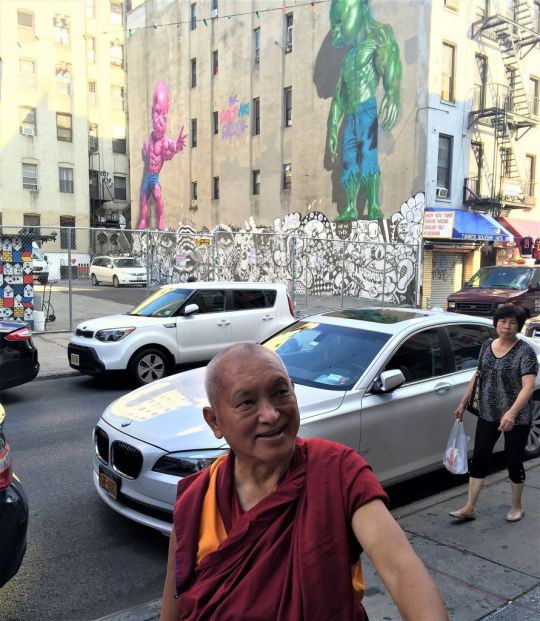
Lama Zopa Rinpoche in New York City, US, 2016. Photo by Ven. Roger Kunsang.
Do we have to go to a retreat center or a faraway country to really meditate?
Way back in 1979, Lama Zopa Rinpoche responded to this question with a teaching on how to practice Dharma in the city.
Rinpoche said, “We don’t have to live in a hermitage in order to generate the realizations of the steps of the path … The whole thing is mind, so whether we are in the city or in the country, or while we are working, there is a way to gradually generate the realizations of the steps of the path to enlightenment.”
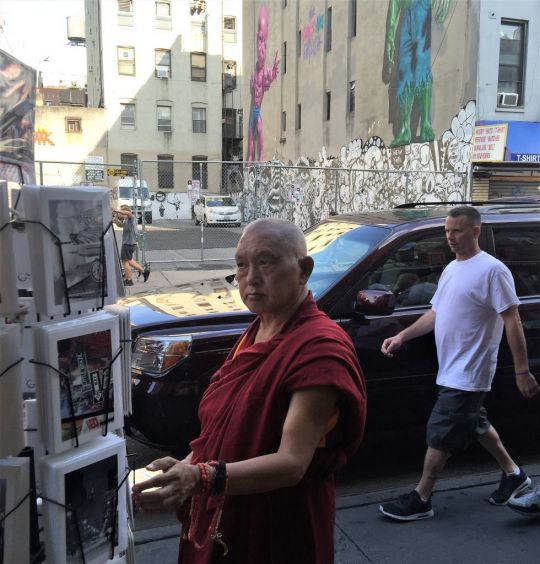
Lama Zopa Rinpoche in New York City, US, 2016. Photo by Ven. Roger Kunsang.
Rinpoche explained, “Each day, while we are working, living with our family, living in the city, we can leave impressions of the stages of the path to enlightenment in our mind, by making sessions of one hour or half an hour each day, similar to those who live in the hermitage … Do some sessions in the morning or evening, then in the daytime, in the break times, be aware—constantly watch the mind; watch the actions of the body, speech, and mind. As much as possible practice lamrim in the break times, and by watching the mind we know what action the body is doing, what action the speech is doing, what action the mind is doing, we are able to recognize. Then also we find out when delusion is arising or not arising; we recognize whatever the delusion is and when it is about to arise. While it is arising, remember the teachings and the different meditations, and apply them …

Lama Zopa Rinpoche walking in New York City, US, July 2016. Photo by Nan Meng.
“Try to remember bodhichitta and practice bodhichitta … Whatever activity we are doing, try to relate it to the practice of bodhichitta. If our daily activities are not possessed by attachment, clinging to the happiness of this life; if we watch the mind and control the unsubdued mind with the meditation techniques, then the motivation is not possessed by the attachment clinging to the happiness of this life and all our actions become Dharma, the cause of happiness.”
Rinpoche concluded, “Then as we remember bodhichitta, as we relate with the practice of bodhichitta, any activity that we do with the practice of bodhichitta—all our work in the factories, on the ships, or in business—becomes the cause to achieve enlightenment. If our activities are done with the motivation of bodhichitta, they become the bodhisattva’s practice. So even if we live far away from the guru—in the city or with our family—there is a possibility of doing this.”
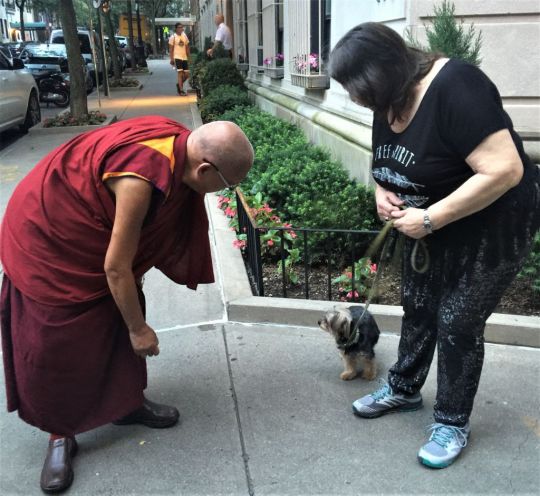
Lama Zopa Rinpoche blessing a dog on a city street, New York City, US, 2016. Photo by Ven. Roger Kunsang.
Find the original teaching here:
https://www.lamayeshe.com/article/practicing-lam-rim-householder
Lama Zopa Rinpoche is the spiritual director of the Foundation for the Preservation of Mahayana Tradition (FPMT), a Tibetan Buddhist organization dedicated to the transmission of the Mahayana Buddhist tradition and values worldwide through teaching, meditation and community service.
- Tagged: bodhichitta, city, lama zopa rinpoche, lamrim, mind training
17
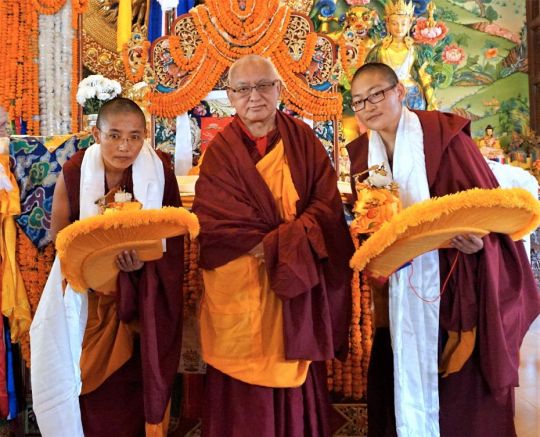
Lama Zopa Rinpoche with Geshes Namdrol Phuntsok and Jangchub Gyalmo, Kopan Nunnery, Nepal, November 2016. Photo by Ven. Lobsang Sherab.
Kopan Nunnery has its first two geshemas. They are Geshe Namdrol Phuntsok and Geshe Jangchub Gyalmo, who graduated with their Geshe degrees in 2016 after an intense program lasting more than twenty years. Lama Zopa Rinpoche met with them in November 2016 at Kopan Nunnery to congratulate them—and to watch them debate philosophy, a skill they honed during their years of study (see video below).
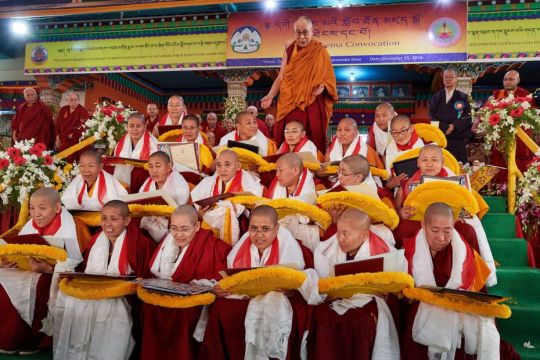
His Holiness the Dalai Lama with the first Himalayan geshemas at their graduation ceremony, Drepung Monastery, India, December 2016. Photo by Olivier Adam.
While many people have commented on the great benefits the geshemas will bring to others by teaching and mentoring, what benefits will their studies bring to them?
In a letter sent to a student in 2014 on the merit of in-depth Dharma study, Lama Zopa Rinpoche pointed out that those who follow their guru’s advice to undertake serious study create tremendous merit. Speaking directly to such students, he stated that this merit “means unbelievable, most unbelievable imprints are left on your mind. It means even if you don’t actualize the path in this life, because of doing this study and purifying so much, in the next life you will meet the Buddha’s teachings and be able to learn, because you have purified so much past negative karma and obscurations. This helps to achieve a higher rebirth, a perfect human rebirth, to meet the Dharma again and to become so expert and through that to have realizations through practicing, and not only that, to be able to go to nirvana and to enlightenment. That is so great!”

Watched by Lama Zopa Rinpoche, Geshes Namdrol Phuntsok and Jangchub Gyalmo debate a monk at Kopan Nunnery, Nepal, November 2016. Photo by Ven. Lobsang Sherab.
Rinpoche continued, saying, “That means each time we are studying, we are fulfilling our Guru’s wishes, so we are becoming closer to enlightenment each time. We become closer to being free from samsara, and closer to enlightenment. So this is what has been happening all these years that you have been studying, doing homework, attending classes, these are the benefits of that. So you have gained unbelievably, so much … Therefore you should rejoice, it is most unbelievable, your whole life should be filled with incredible joy and happiness.”
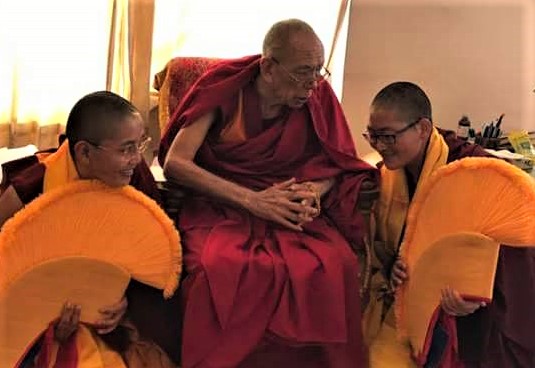
Kopan Nunnery’s two new geshemas with Rizong Rinpoche, former Ganden Tripa, Nepal, November 2016. Photo by Mukhiya Ghale.
“Among all the sentient beings,” Rinpoche concluded, “the amount of people who are Buddhists is so small. Then from those who are Buddhist, those who have the opportunity to study are very rare. Then to be able to find a qualified teacher who can teach philosophy, it’s so, so rare. So you can rejoice, it’s unbelievable.”
Join Lama Zopa Rinpoche in rejoicing at the graduation of the geshemas. Watch them debate in front of Rinpoche and Rizong Rinpoche, former Ganden Tripa (head of the Gelug school of Tibetan Buddhism), at Kopan Nunnery, Nepal, in November 2016:
https://www.youtube.com/watch?v=SexrtqnobdM&feature=youtu.be
Lama Zopa Rinpoche is the spiritual director of the Foundation for the Preservation of Mahayana Tradition (FPMT), a Tibetan Buddhist organization dedicated to the transmission of the Mahayana Buddhist tradition and values worldwide through teaching, meditation, and community service.
12
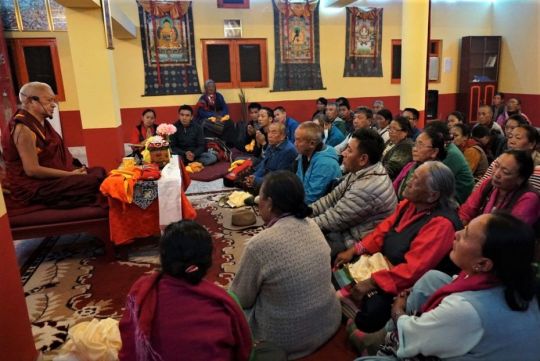
Lama Zopa Rinpoche giving teachings to a group of Sherpas at Root Institute, Bodhgaya, India, January 2017. Photo by Ven. Lobsang Sherab.
Lama Zopa Rinpoche gave a wonderful teaching on the Seven-Point Mind Training (also called Seven-Point Thought Transformation) on February 5, 2017, at Root Institute in Bodhgaya, India. The mind training (Tibetan: lojong) text Rinpoche taught was by Kadampa Geshe Chekawa.
A video of this three-hour teaching appears below. It can also be found on Rinpoche Available Now, FPMT’s website of Lama Zopa Rinpoche’s latest teachings online.
Rinpoche taught Geshe Chekawa’s well-known text by following a verse commentary on it by Lama Tsongkhapa, entitled in English as Mind Training in Ornamental Words or Twenty-Seven Verses on Mind Training.
At a long life puja offered to him last year in Singapore, all FPMT centers requested Rinpoche to teach lojong, on the advice of Khadro-la (Rangjung Neljorma Khadro Namsel Drönme). She had indicated that giving this particular teaching would help ensure Lama Zopa Rinpoche’s long life.
Watch Rinpoche teaching the Seven-Point Mind Training on YouTube:
https://youtu.be/Jbf0ZcNLZmM
See more videos of teachings by Lama Zopa Rinpoche at Root Institute in 2017 at Rinpoche Available Now:
https://fpmt.org/media/
Get a free PDF of Geshe Chekawa’s mind training text through the Foundation Store:
https://shop.fpmt.org/The-Seven-Point-Thought-Transformation-PDF_p_3542.html
Lama Zopa Rinpoche is the spiritual director of the Foundation for the Preservation of Mahayana Tradition (FPMT), a Tibetan Buddhist organization dedicated to the transmission of the Mahayana Buddhist tradition and values worldwide through teaching, meditation and community service.
- Tagged: bodhgaya, essential extract, kadampa teachings, lama zopa rinpoche, lo-jong, mind training, video
10
Feed the Birds

Lama Zopa Rinpoche blessing birds in Bodhgaya, India, January 2017. Photo by Ven. Lobsang Sherab. The birds are released from the cages after being blessed.
In 2007, Lama Zopa Rinpoche talked about the benefits of feeding birds, saying, “When we give food to birds we should chant the Mitukpa, Medicine Buddha, Chenrezig, and the five powerful mantras and then blow over the food. Giving food to birds protects them from hunger and thirst. The most important benefit is that it purifies negative karma and defilements. It helps them to not be born in the lower realms, by purifying them. It blesses their minds. By giving food in this way, it becomes a practice of loving kindness, of giving material things, and of giving fearlessness and purifying negative karma. There is so much suffering and fear in the lower realms and this is a way to protect them from it.”
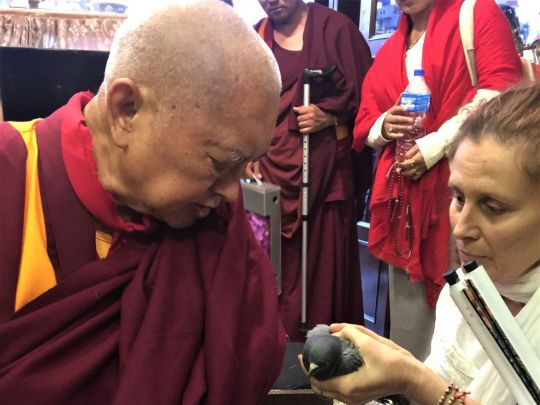
Lama Zopa Rinpoche recites mantras for an injured bird, Kopan Monastery, Nepal, December 2016. Photo by Ven. Roger Kunsang.
Rinpoche continued. “Feeding the birds and the other animals doesn’t have to be done for one’s own pleasure but can instead be a sincere practice of giving … You are offering fearlessness by saying mantras and then blowing on the food or water. This is morality working for sentient beings—giving sentient beings what they need. Giving food and water is material generosity. When mantras are said and blown upon the food and water it becomes the charity of fearlessness, and when you play the mantras so that the animals can hear them it becomes the charity of Dharma.”
Read the complete teaching here:
https://www.lamayeshe.com/advice/protecting-and-feeding-birds
See more information and a video on How to Benefit the Bodies and Minds of Birds here:
https://fpmt.org/lama-zopa-rinpoche-news-and-advice/lama-zopa-rinpoche-news/how-to-benefit-the-bodies-and-minds-of-birds-video/
Lama Zopa Rinpoche is the spiritual director of the Foundation for the Preservation of Mahayana Tradition (FPMT), a Tibetan Buddhist organization dedicated to the transmission of the Mahayana Buddhist tradition and values worldwide through teaching, meditation and community service.
- Tagged: animals, birds, lama zopa rinpoche
5
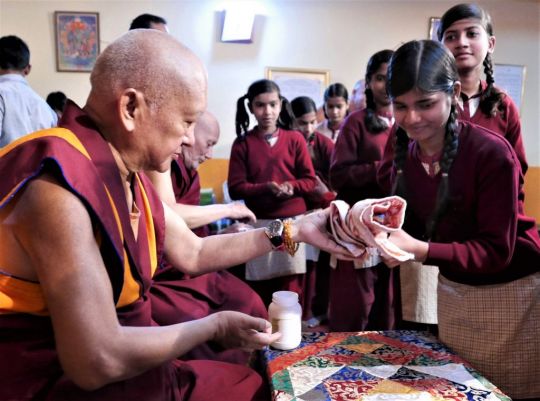
Lama Zopa Rinpoche offers gifts to children at FPMT’s Maitreya School, Bodhgaya, India, January 2017. Photo by Ven. Roger Kunsang.
Lama Zopa Rinpoche cares deeply about children. Indeed, his Vast Visions include a focus on young people. What does Rinpoche say about children and youth?
Rinpoche has commented, “[FPMT should] help young people through meditation and consultation, and also help them offer volunteer service as part of their practice. This brings immediate benefit.”
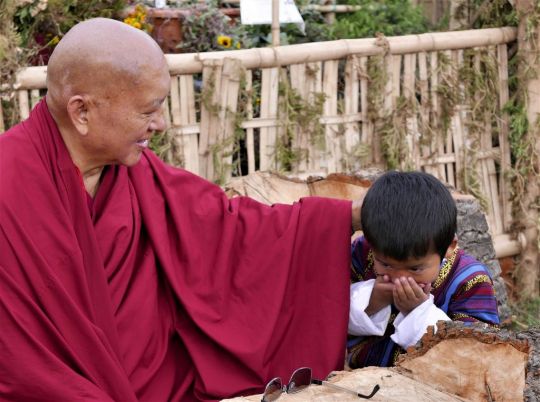
Lama Zopa Rinpoche blesses a small boy who covers his mouth to show respect, Bhutan, June 2016. Photo by Ven. Roger Kunsang.
Rinpoche has also explained his thoughts on raising children: “The best way to take care of children is to think of them simply as a sentient being rather than as my child. For example, when you generate bodhichitta for all sentient beings … it goes without saying that you [include] your own children … If you think in this way, you will have the same motivation to care for your children as you would any sentient being … So when you begin a practice with the motivation of bodhichitta, the thought to achieve enlightenment for all sentient beings, recall that your child is one of those sentient beings and do the practice with that awareness. Similarly, when you conclude a practice with the dedication to achieve enlightenment for the sake of all sentient beings, remember that your child is one of those sentient beings …”
Rinpoche adds, “Because you, as a parent, have a particular karmic connection with and are responsible for the specific sentient beings that are your children, you should always pay special attention to the fact that your children are included among those sentient beings. By thinking in this way, you will have a totally different attitude toward your children; there will not be the slightest negative thought caused by the eight worldly concerns, and instead you will take care of them motivated by the positive thought of cherishing a sentient being.”
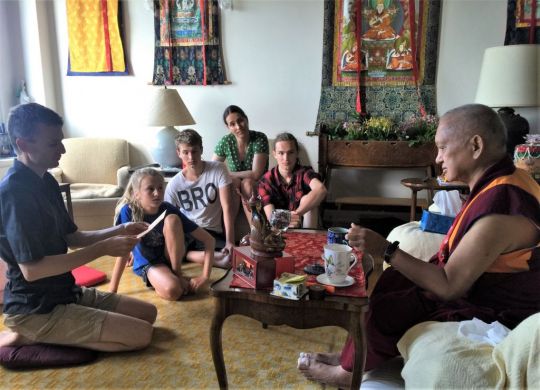
Lama Zopa Rinpoche visits with young people in New York City, USA, 2016. Photo by Ven. Roger Kunsang.
“On the other hand,” he continues, “if you allow yourself to come under the influence of the eight worldly concerns, when your children do something to please you, something that you like, you will happily take care of them. However, when they do something that is contrary to your wishes, something that upsets you or makes you angry, you may even be tempted to give them up entirely. This change in your attitude towards them happens because you are attached to your own happiness and want to avoid suffering and problems. With bodhichitta, you feel that your children are the most precious and the kindest beings in your life. If you have this attitude, you will take care of them with a healthy positive mind rather than with a negative emotional mind and the pain of attachment.
“As a parent, you can make yourself happy by thinking:
How wonderful that my life can be beneficial for even one sentient being.
How wonderful that I can take care of even one sentient being.
How wonderful that my limbs can be useful for looking after and bringing happiness to even one sentient being.
“Especially when you encounter difficulties—when your children do not listen to you, when you cannot control them and when you feel disappointed with them—it is good to rejoice in these ways.”
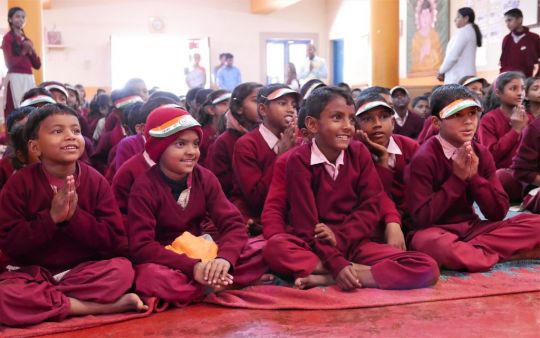
Children at FPMT’s Maitreya School in Bodhgaya, India, listen to Lama Zopa Rinpoche, January 2017. Photo by Ven. Roger Kunsang.
In 2013, Rinpoche dictated a special prayer for children to do, and gave a short commentary on it, in response to one center’s request for a prayer for children to recite:
https://www.lamayeshe.com/advice/prayer-children
As a result of the interest Rinpoche and others take in the welfare and spiritual development of children, FPMT has various initiatives aimed at young people including Tara Redwood School, Creating Compassionate Cultures, Maitreya School, and children’s programs at some centers.
Read the complete teaching by Lama Zopa Rinpoche on raising children with bodhichitta:
https://www.lamayeshe.com/article/chapter/1-raising-children-bodhicitta
Lama Zopa Rinpoche explains how we can teach our children the good qualities and behavior that are essential for achieving every type of happiness, both short- and long-term, in the book Joyful Parents, Successful Children. Get the ebook from the Foundation Store and support FPMT International Office: https://shop.fpmt.org/Joyful-Parents-Successful-Children-eBook_p_2710.html
Lama Zopa Rinpoche is the spiritual director of the Foundation for the Preservation of Mahayana Tradition (FPMT), a Tibetan Buddhist organization dedicated to the transmission of the Mahayana Buddhist tradition and values worldwide through teaching, meditation, and community service.
3
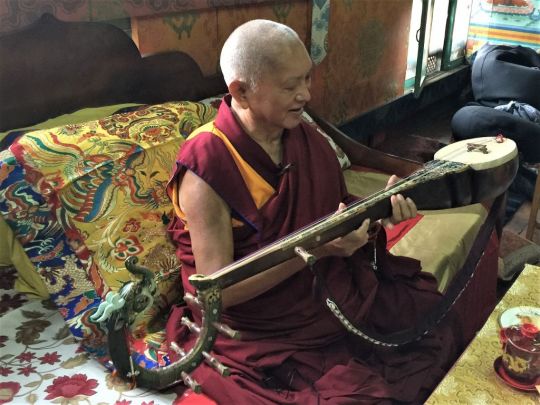
Lama Zopa Rinpoche examines an instrument while visiting a home where he was offered music, Bhutan, June 2016. Photo by Ven. Roger Kunsang.
Is it good to play music?
“Music can bring so much joy and happiness to people,” said Lama Zopa Rinpoche in 2005, “especially if it’s performed with a good motivation.”
In explaining how to play music in the most beneficial way, he added, “Also, if one is able to play purely to bring joy to others then one becomes less attached to music being ‘my music’. In that way, you don’t break vows or create negative karma. Also, you can visualize when you play music that you are offering clouds of music to all the buddhas and bodhisattvas of the ten directions who are in essence your own root guru.”
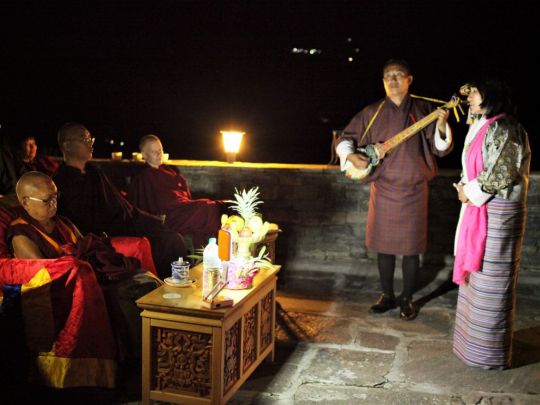
Singer Lhamo Dukpa offers a song to Lama Zopa Rinpoche, Bhutan, June 2016. Photo by Ven. Losang Sherab.
“In this way,” Rinpoche concluded, “you not only bring the music of bodhichitta to all the listeners, through your good motivation, but you also create vast amounts of merit by offering to your guru, who is in essence all of the buddhas.”
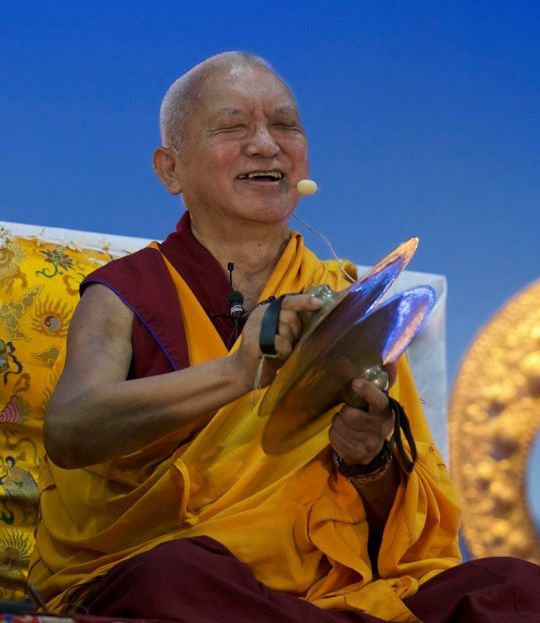
Lama Zopa Rinpoche enjoying playing the cymbals. Photo by Bill Kane.
Lama Zopa Rinpoche is the spiritual director of the Foundation for the Preservation of Mahayana Tradition (FPMT), a Tibetan Buddhist organization dedicated to the transmission of the Mahayana Buddhist tradition and values worldwide through teaching, meditation and community service.
- Tagged: lama zopa rinpoche, music, offerings
27
Lama Zopa Rinpoche on Art
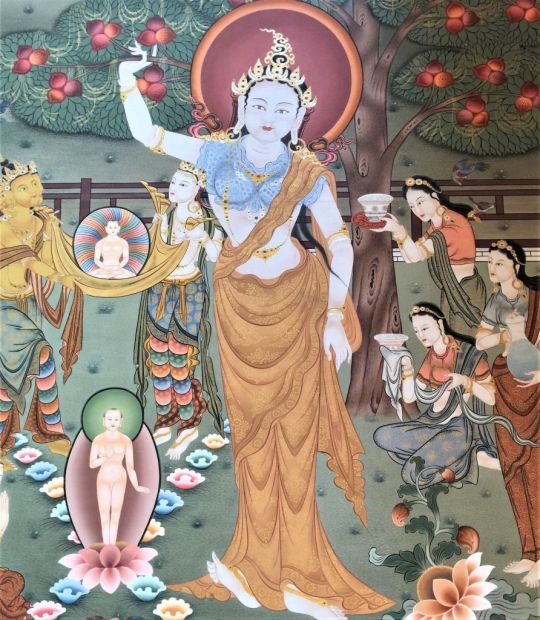
A wall painting of the Buddha’s mother inside the Buddha Dordenma statue, photographed during Lama Zopa Rinpoche’s visit to the site, Bhutan, June 2016. Photo by Ven. Roger Kunsang.
Can creating art be a Dharma practice?
Lama Zopa Rinpoche discussed this in 2005. Here is what he said:
“The first thing to think about,” explained Rinpoche, “is one’s attitude. The purpose of making the painting or of creating any work of art should only be to benefit others. One should do the artwork to pacify all one’s wrong concepts and disturbing emotional thoughts. While creating, one should keep a motivation of purifying negative karma and actualizing the good heart, loving kindness, bodhichitta, and, in fact, the whole path to enlightenment. By transforming one’s attitude into Dharma, one integrates one’s art with Dharma.”
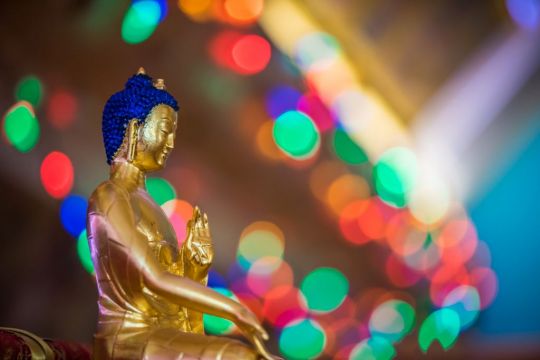
A photo of a Buddha statue with lights around it taken at Buddha Amitabha Pure Land. Photo by Chris Majors.
Rinpoche continued, “The second thing is the art itself. One should make objects that have a spiritual meaning. One can represent bodhisattvas’ life stories or the Buddha’s life story, showing how they practiced patience and perseverance for the happiness of other sentient beings. One could paint the life stories of great holy beings and present the ways they sacrificed their lives for other sentient beings by practicing renunciation, bodhichitta, and emptiness. One could show how they were always aware of karma. One could use art to show how happiness results from good actions and suffering from negative actions. [This] … is the integration of art with Dharma.”

Ani Wy painting the face of the Buddha during a visit of Lama Zopa Rinpoche, Penang, Malaysia, April 2016. Photo by Ven. Roger Kunsang.
Rinpoche concluded, “At the beginning of every day, one should pray like this: Due to all my past and future merits, may anyone who sees, touches, or remembers this painting (or other object) never be born in the lower realms. May all disturbing spirit harms and obscurations be purified. May they achieve enlightenment as soon as possible by actualizing the whole path and may they have joy and happiness in their hearts.”

Lama Zopa Rinpoche examines a painting of Namtose at the National Museum of Bhutan, Paro, Bhutan, May 2016. Photo by Ven. Lobsang Sherab.
Find the original teaching here:
https://www.lamayeshe.com/advice/art-and-dharma
Lama Zopa Rinpoche is the spiritual director of the Foundation for the Preservation of Mahayana Tradition (FPMT), a Tibetan Buddhist organization dedicated to the transmission of the Mahayana Buddhist tradition and values worldwide through teaching, meditation and community service.
- Tagged: art, bodhichitta, lama zopa rinpoche
20
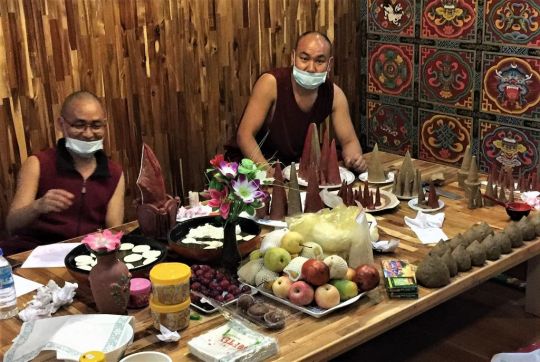
Vens. Sherab and Tendar, attendants of Lama Zopa Rinpoche, make tormas for a puja Rinpoche will preside over, Bhutan, June 2016. Photo by Ven. Roger Kunsang.
What exactly are tormas? The word is Tibetan (the Sanskrit is balingta) and refers to an offering cake used in rituals. There are various different types of tormas for different purposes.
Tormas can be ornamented in many ways, such as with discs molded from butter that represent the sun and moon. More elaborate tormas feature multiple colors. In Tibet, tormas were usually made of tsampa (roasted barley flour), but these days other edibles such as biscuits can also be used. The practice of offering tormas can be a way to accumulate merit and eliminate obstacles.

Elaborate tormas made of tsampa and butter inside the Great Buddha Dordenma, a large Shakyamuni Buddha statue in Bhutan. The photo was taken when Lama Zopa Rinpoche visited the statue. Bhutan, June 2016. Photo by Ven. Roger Kunsang.
Lama Zopa Rinpoche explained the origins and meaning of the word torma during teachings at Shakyamuni Center in Taiwan in February 2007.
“Tor in Tibetan is that which, when the hurricane or tornado comes, the whole city, whole town, after one hour, is totally destroyed, everywhere pieces, all the houses gone, so all the pieces are tor. Or when in a field you plant crops you throw seeds, this is called tor. Or when you give grain, when you give food to birds, you tor, but not so much that, tor is more like the hurricane destroying a city or town, after half an hour, one hour, totally, everything is scattered. Tor is like that, something scattered or destroyed. Tor is more in the sense of destroy. So torma, that which destroys.
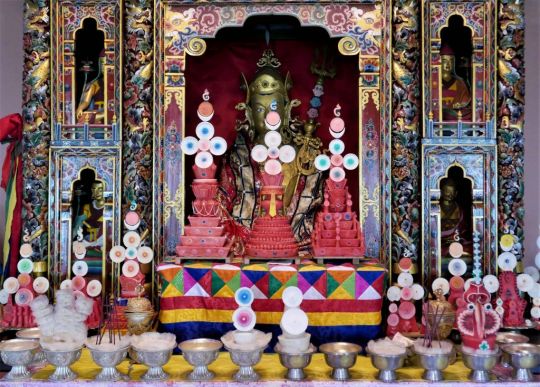
A variety of elaborate tormas could be seen on the altar at Satsam Chorten, Bhutan, when Lama Zopa Rinpoche visited there, Bhutan, June 2016. Photo by Ven. Roger Kunsang.
“So one meaning of torma is destroying miserliness, your miserliness, so therefore torma are made very rich, the best and richest quality you can make. It means you spend money destroying your miserliness, making a good offering to the deity. So that’s one meaning of tor, that which destroys your miserliness, your attachment.
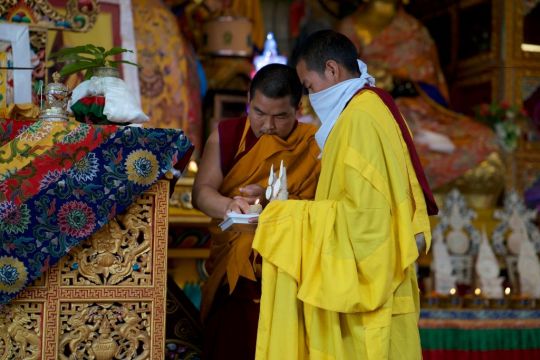
At Kopan Monastery, monks offer small tormas to Lama Zopa Rinpoche during a long life empowerment. Larger tormas stand on the altar in the background. Nepal, March 2017. Photo by Bill Kane.
“Then the other meaning is related also to the maha-anuttara tantric path, where the experience of transcendental wisdom, the great bliss, the voidness, is the real torma. That is the real torma … So then that tor destroys like a bomb; it destroys the root of samsara: the ignorance holding the I, the aggregates, to be truly existent. So the torma is that which destroys that …

A monk offering a red-colored torma as tsog during lama dances at Kopan Monastery, December 2016. Photo by Laura Miller.
“Just one more word, then finish. Why do Tibetans make tormas so beautiful, with decorations and shapes, as beautiful as they can make them? It creates the cause to have beautiful bodies in future lives if you make the tormas very beautiful …”
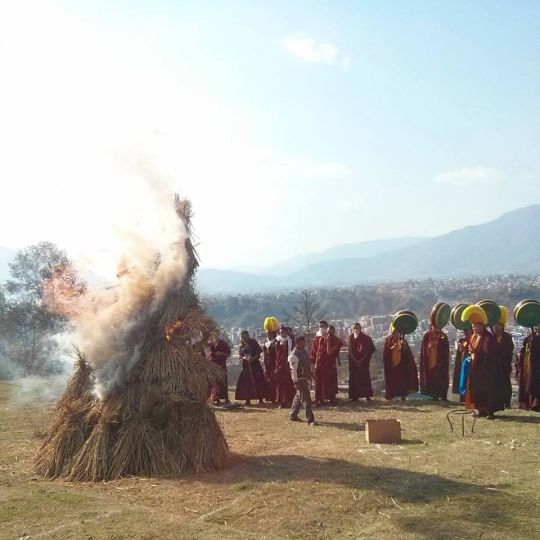
A special torma is wrapped in straw and burned on the Day of Miracles to symbolize the destruction of all negativities, Kopan Monlam, Kopan Monastery, Nepal, March 15, 2017. Photo by Laura Miller.
Lama Zopa Rinpoche is the spiritual director of the Foundation for the Preservation of Mahayana Tradition (FPMT), a Tibetan Buddhist organization dedicated to the transmission of the Mahayana Buddhist tradition and values worldwide through teaching, meditation and community service.
- Tagged: lama zopa rinpoche, offering, ritual, tormas
- 0
15
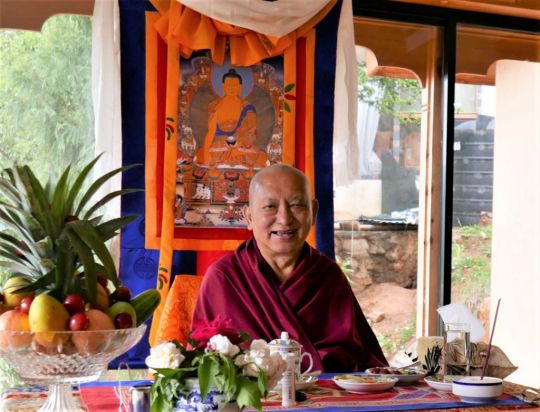
Lama Zopa Rinpoche in front of a thangka of the Buddha in a restaurant in Paro, Bhutan, May 2016. Photo by Ven. Roger Kunsang.
Lama Zopa Rinpoche gave a concise teaching last April at Losang Dragpa Centre in Malaysia on “the kindness of the enemy,” now available in a 20-minute video.
“What is the advice?” asked Rinpoche. “Take the loss on yourself and offer the victory to others!”
“That,” he emphasized, “is the practice of Buddhism, especially Mahayana Buddhism. That is the advice. That is what the Buddha practiced.”
Rinpoche added, “You don’t fight, peace, then practice patience, good heart, peace. In this way, what happens? It looks like you lost, like you are stupid. People in the world think you don’t know anything, you lost, you are stupid. People in the world think that … [But] in this way, offering the victory and taking the loss on yourself now, for many lifetimes, so many lifetimes, wow, wow, wow, hundreds, thousands you win, you win, all the future you win, you win, so many times, not just one time, so many times you win!”

Lama Zopa Rinpoche teaching in Kuala Lumpur, Malaysia, April 2016. Photo by Ven. Roger Kunsang.
At the end of the talk, Rinpoche emphasized that through the practice of patience, the enemy who is angry at you “is giving you enlightenment so that you can free numberless sentient beings from oceans of samsaric sufferings, not only that, you bring them to peerless happiness, cessation of all mistakes and completion of all realizations … so the kindness is wow, wow. Their anger is very needed by you … You understand? So the kindness of the enemy, wow, wow, wow!”
Watch Lama Zopa Rinpoche share this teaching on YouTube:
https://www.youtube.com/watch?v=DixeHnan8BE&feature=youtu.be
Lama Zopa Rinpoche is the spiritual director of the Foundation for the Preservation of Mahayana Tradition (FPMT), a Tibetan Buddhist organization dedicated to the transmission of the Mahayana Buddhist tradition and values worldwide through teaching, meditation and community service.
- Tagged: anger, kadampa teachings, lama zopa rinpoche, patience
- 0
10
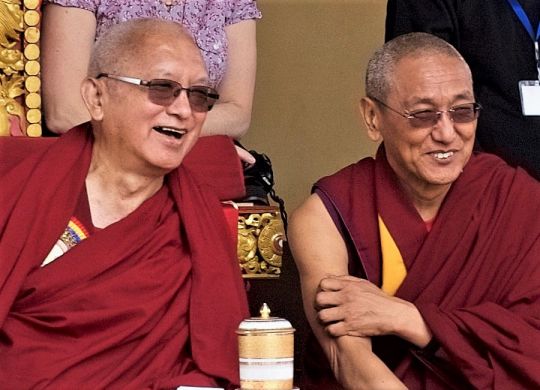
Lama Zopa Rinpoche and Kopan abbot Khen Rinpoche Geshe Chonyi share a smile while watching the performances after the enthronement of Thubten Rigsel Rinpoche. Photo by Bill Kane.
Lama Zopa Rinpoche has been staying at Kopan Monastery since late February.
Rinpoche first celebrated Tibetan New Year (Losar) at Kopan.
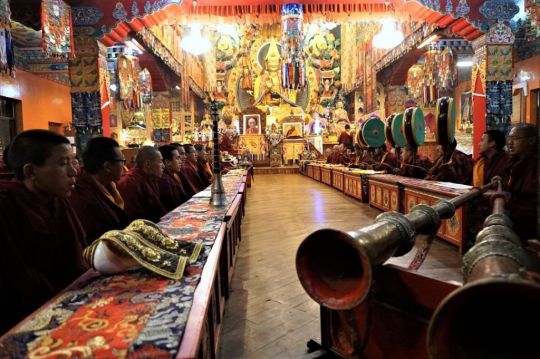
Palden Lhamo puja early morning on Tibetan New Year (Losar), presided over by Lama Zopa Rinpoche, Kopan Monastery, Nepal, February 2017. Photo by Ven. Lobsang Sherab.
He also circumambulated and made offerings at stupas in Boudhanath and Swayambu.
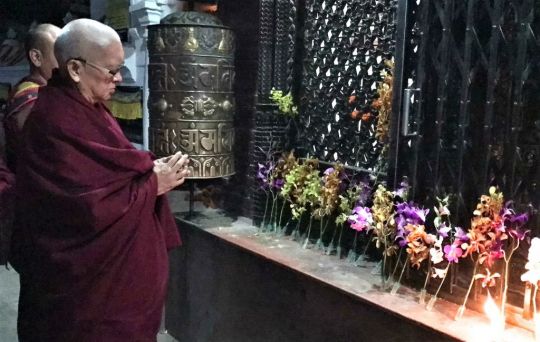
Lama Zopa Rinpoche making late night flower offerings at Boudhanath Stupa, Nepal, March 2017. Photo by Bill Kane.
As well, he presided over the enthronement of Thubten Rigsel Rinpoche (the reincarnation of Khensur Rinpoche Lama Lhundrup, Kopan’s former abbot), a celebration that attracted almost a thousand visitors to Kopan, and he visited the Himalayan Buddhist Meditation Centre in Kathmandu.
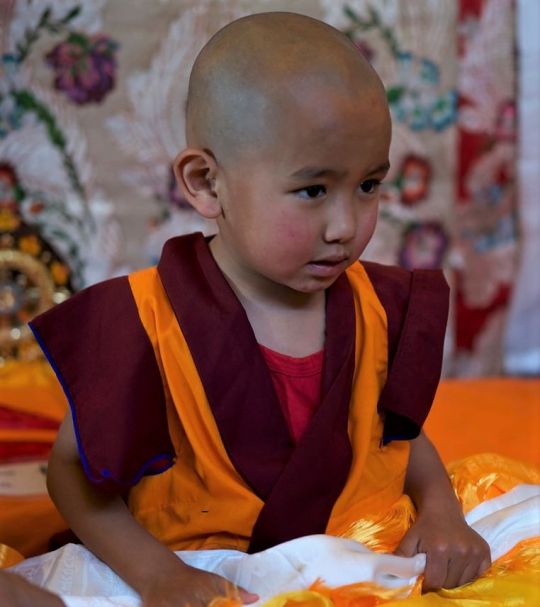
Thubten Rigsel Rinpoche at his enthronement, Kopan Monastery, March 6, 2017. Photo by Bill Kane.
Rinpoche also met with His Eminence Jangtse Chöje Lobsang Tenzin Rinpoche, who came to Kopan to attend the Great Prayer Festival (Monlam Chenmo) and teach on mind training on March 14. Jangstse Chöje Rinpoche received a warm welcome when he arrived, with gyalings, cymbals, and banners, and lines of students offering khatas.
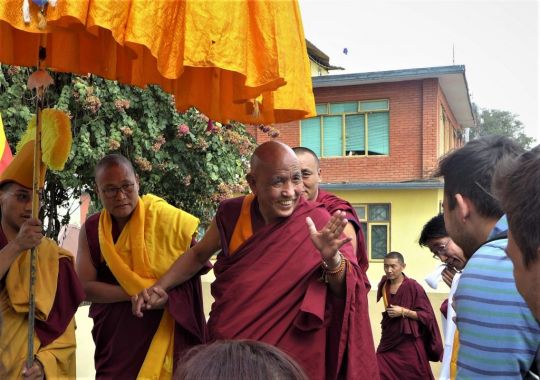
His Eminence Jangtse Chöje Rinpoche arriving at Kopan Monastery, March 2017. Photo by Laura Miller.
Lama Zopa Rinpoche also met with Yangsi Rinpoche, IMI Sangha, and other lamas and dignitaries.
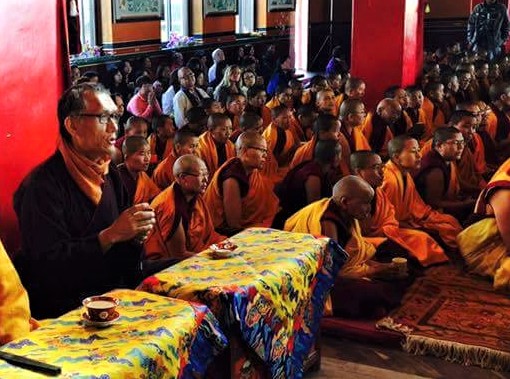
Yangsi Rinpoche participating in the enthronement of Thubten Rigsel Rinpoche, Kopan Monastery, Nepal, March 2017. Photo by Bill Kane.
While at Kopan, Rinpoche also visited with students doing a three-month Vajrasattva retreat at the monastery, and gave them encouragement and advice.
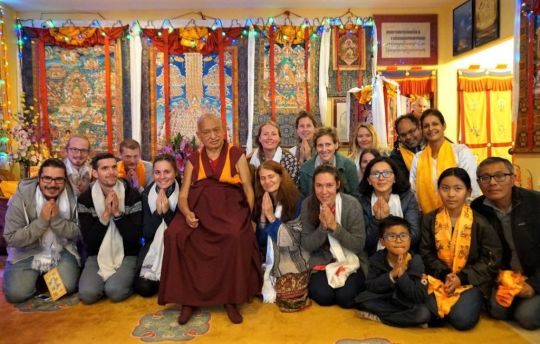
Lama Zopa Rinpoche with the Vajrasattva retreatants during their three-month retreat at Kopan Monastery, Nepal, March 2017. Photo by Ven. Lobsang Sherab.
On March 7, Lama Zopa Rinpoche gave an Amitayus long life initiation attended by Tenzin Phuntsok Rinpoche and his younger brother, the newly enthroned Thubten Rigsel Rinpoche, among many others.
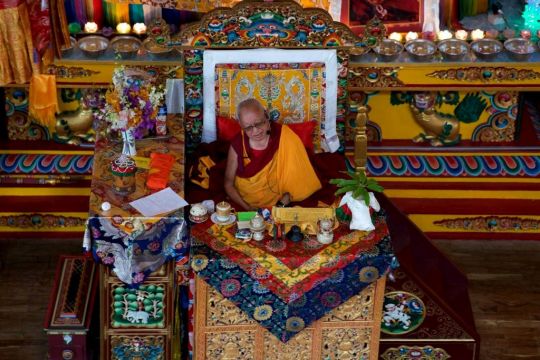
Lama Zopa Rinpoche giving a long life empowerment, Kopan Monastery, Nepal, March 7, 2017. Photo by Bill Kane.
Rinpoche later attended a Lama Chöpa with tsog, where he was joined by Jangtse Chöje Rinpoche. The gompa was full for this precious opportunity for both monastic and lay students to celebrate Lama Chöpa with their revered lamas; robes and funds were offered to Sangha, and the tsog overflowed. After the puja, Lama Zopa Rinpoche gave a talk about the importance of circumambulation, stressing the need for setting a beneficial motivation and describing how to visualize offering rice to a stupa.
Rinpoche’s visit to Kopan was honored with a grand thank-you dinner at the Hyatt Hotel in Kathmandu, located near Boudhanath Stupa. The meal was attended by approximately 400 people, including many of the international guests who came for the enthronement of Thubten Rigsel Rinpoche, senior Kopan monks and nuns, IMI Sangha, and local volunteers who helped during the three days of enthronement celebrations. Kopan’s abbot, Khen Rinpoche Geshe Chonyi, and Paula de Wijs-Koolkin, who first came to Kopan in 1972 and attended the November course that year, gave short speeches after dinner. (Three other people who attended the November 1972 course were also present for the enthronement celebrations—Ven. Yeshe Khadro, Luca Corona, and Marcel Bertels.)
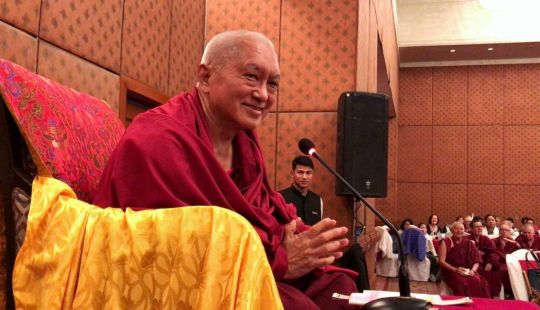
Lama Zopa Rinpoche speaking to attendees at the dinner at the Hyatt. Nepal, March 2017. Photo by Bill Kane.
After the meal, Lama Zopa Rinpoche gave advice again on circumambulation, and close to 200 people followed him over to Boudhanath Stupa. There, Rinpoche led them in seven circumambulations around the stupa, stopping occasionally to give reminders about motivation, offer advice, and, at the end, lead a dedication. The circumambulation ended around midnight, and—tired but joyful—those present said goodnight to each other and to Rinpoche.
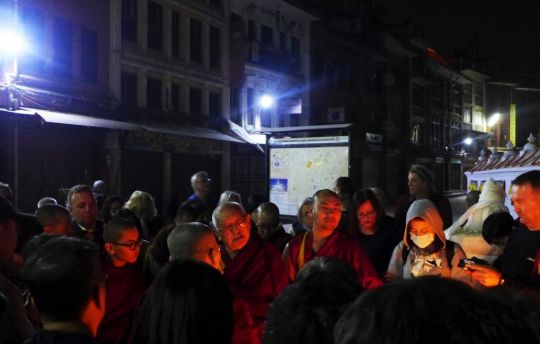
Lama Zopa Rinpoche leading dedications late at night after circumambulating Boudhanath Stupa with a group of students, Nepal, March 8, 2017. Photo by Laura Miller.
Lama Zopa Rinpoche is the spiritual director of the Foundation for the Preservation of Mahayana Tradition (FPMT), a Tibetan Buddhist organization dedicated to the transmission of the Mahayana Buddhist tradition and values worldwide through teaching, meditation, and community service.
- Tagged: kopan monastery, lama zopa rinpoche, losar, nepal, stupas, thubten rigsel rinpoche
8
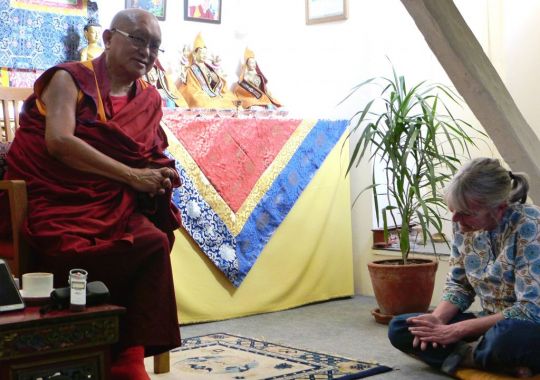
Lama Zopa Rinpoche giving a talk at the Himalayan Buddhist Meditation Centre, with spiritual program coordinator Holly Guy listening, Nepal, March 2017. Photo by Laura Miller.
On March 2, 2017, Lama Zopa Rinpoche visited the new location of FPMT’s center in Kathmandu, Nepal, known as the Himalayan Buddhist Meditation Centre (HBMC). HBMC was established in 1982 by Lama Yeshe and offers teachings and meditation. In recent years, teachings have been given there by Cherok Lama, who was born in 1993 in Nepal, as well as by FPMT registered teachers Ven. Robina Courtin, Ven. Joan Nicell, Jimi Neal, and others.
A year ago, HBMC was forced to move from its old location in the popular Thamel district of Kathmandu to the Naxal area due to damage caused to its building by Nepal’s massive April 2015 earthquake. The center is now located in the loft of an historic old house, one of very few of its type that survived the quake. This particular house, over 100 years old, was originally built by a Nepali king as lodging for visiting royal musicians.
During his visit, Rinpoche listened as the new spiritual program coordinator, Holly Guy, described the program the center currently offers as well as ideas for the future. Rinpoche then offered advice for the center’s further development. He also led those present, who were mostly Sangha, in “Praises to the Twenty-One Taras” for the center’s success.

The shrine at the Himalayan Buddhist Meditation Centre, Nepal, March 2017. Photo by Ven. Joan Nicell.
Holly Guy sees much potential in HBMC’s new location. The center is above a pleasant restaurant which also offers several guest rooms. The restaurant, rumored to have excellent food, will help ensure visitors to the center can enjoy themselves over a snack or meal before or after events. The center is also now developing ways to earn income: tours and pilgrimages to holy places in the Kathmandu valley and other sites in the Himalayas.
Before the visit to HBMC, Rinpoche took the Sangha and others for lunch at the popular Yak and Yeti Hotel.

Lama Zopa Rinpoche, Khen Rinpoche Geshe Chonyi, Sangha, and other students lunch at the Yak and Yeti Hotel in Kathmandu after the visit to the Himalayan Buddhist Meditation Centre, Nepal, March 2017. Photo by Ven. Roger Kunsang.
Lama Zopa Rinpoche is the spiritual director of the Foundation for the Preservation of Mahayana Tradition (FPMT), a Tibetan Buddhist organization dedicated to the transmission of the Mahayana Buddhist tradition and values worldwide through teaching, meditation and community service.
- Home
- News/Media
- Study & Practice
- About FPMT Education Services
- Latest News
- Programs
- New to Buddhism?
- Buddhist Mind Science: Activating Your Potential
- Heart Advice for Death and Dying
- Discovering Buddhism
- Living in the Path
- Exploring Buddhism
- FPMT Basic Program
- FPMT Masters Program
- FPMT In-Depth Meditation Training
- Maitripa College
- Lotsawa Rinchen Zangpo Translator Program
- Universal Education for Compassion & Wisdom
- Online Learning Center
- Prayers & Practice Materials
- Overview of Prayers & Practices
- Full Catalogue of Prayers & Practice Materials
- Explore Popular Topics
- Benefiting Animals
- Chenrezig Resources
- Death & Dying Resources
- Lama Chopa (Guru Puja)
- Lama Zopa Rinpoche: Compendium of Precious Instructions
- Lama Zopa Rinpoche: Life Practice Advice
- Lama Zopa Rinpoche Practice Series
- Lamrim Resources
- Mantras
- Prayer Book Updates
- Purification Practices
- Sutras
- Thought Transformation (Lojong)
- Audio Materials
- Dharma Dates – Tibetan Calendar
- Translation Services
- Publishing Services
- Teachings and Advice
- Find Teachings and Advice
- Lama Zopa Rinpoche Advice Page
- Lama Zopa Rinpoche: Compendium of Precious Instructions
- Lama Zopa Rinpoche Video Teachings
- ༧སྐྱབས་རྗེ་བཟོད་པ་རིན་པོ་ཆེ་མཆོག་ནས་སྩལ་བའི་བཀའ་སློབ་བརྙན་འཕྲིན།
- Podcasts
- Lama Yeshe Wisdom Archive
- Buddhism FAQ
- Dharma for Young People
- Resources on Holy Objects
- Ways to Offer Support
- Centers
- Affiliates Area
- Teachers
- Projects
- Charitable Projects
- Make a Donation
- Applying for Grants
- News about Projects
- Other Projects within FPMT
- Support International Office
- Projects Photo Galleries
- Give Where Most Needed
- FPMT
- Shop
Translate*
*powered by Google TranslateTranslation of pages on fpmt.org is performed by Google Translate, a third party service which FPMT has no control over. The service provides automated computer translations that are only an approximation of the websites' original content. The translations should not be considered exact and only used as a rough guide.The root of your life’s problems becomes non-existent when you cherish others.
